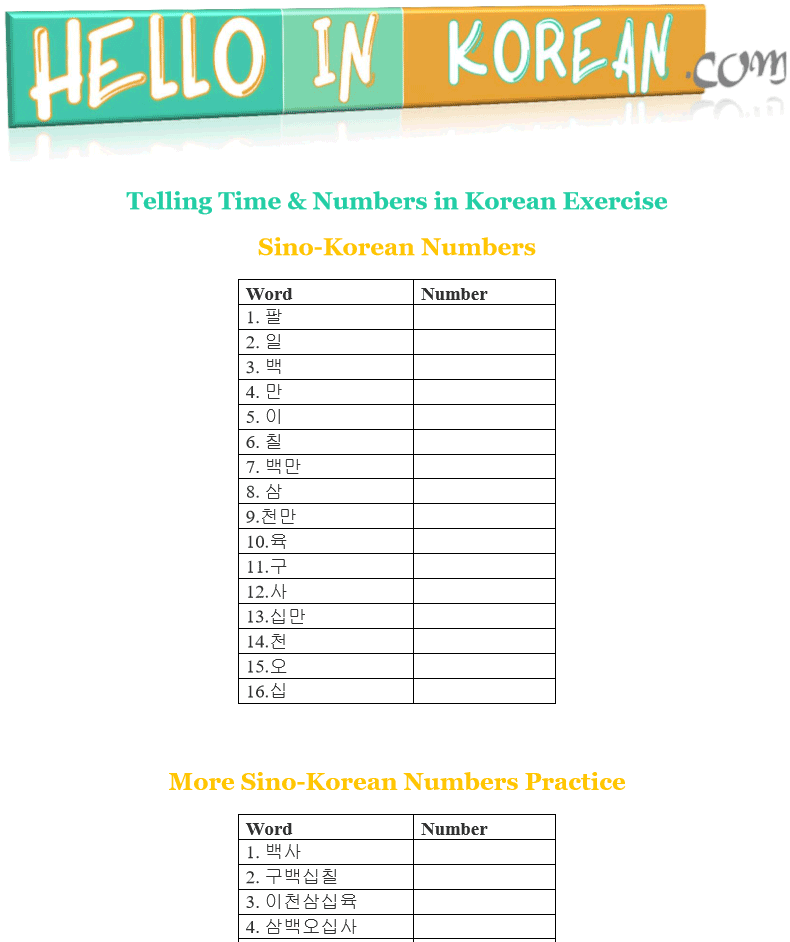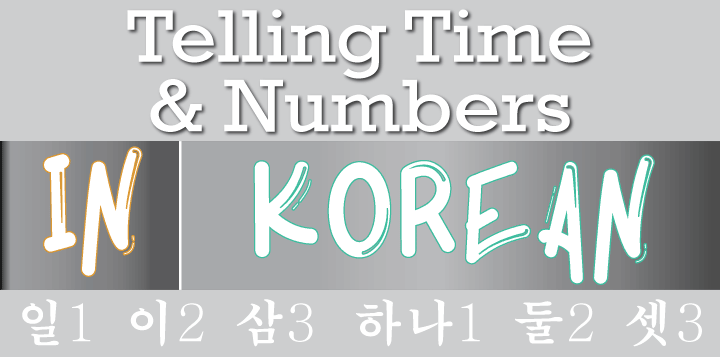Telling Time and Numbers in Korean
There are two sets of numbers in Korean. There are Sino-Korean numbers, derived from Chinese, and Native Korean numbers.
Sino-Korean Numbers
Numbers higher than 10,000 can be difficult because Sino-Korean numbers work with multiples of 10,000. In English we use multiples of 1,000. With some practice you will have it down in no time.
| Sino-Korean | Number |
| 일 | 1 |
| 이 | 2 |
| 삼 | 3 |
| 사 | 4 |
| 오 | 5 |
| 육 | 6 |
| 칠 | 7 |
| 팔 | 8 |
| 구 | 9 |
| 십 | 10 |
| 백 | 100 |
| 천 | 1,000 |
| 만 | 10,000 |
| 십만 | 100,000 |
| 백만 | 1,000,000 |
| 천만 | 10,000,000 |
Sino-Korean Numbers Practice
| Sino-Korean | Number | Formula |
| 십일 | 11 | 10 + 1 |
| 십육 | 16 | 10 + 6 |
| 이십 | 20 | 2 * 10 |
| 팔십육 | 86 | 8 * 10 + 6 |
| 백사 | 104 | 100 + 4 |
| 백칠십구 | 179 | 100 + 7 * 10 + 9 |
| 삼백오십사 | 354 | 3 * 100 + 5 * 10 + 4 |
| 구백십칠 | 917 | 9 * 100 + 10 + 7 |
| 천백십구 | 1,119 | 1,000 + 100 + 10 + 9 |
| 이천삼십육 | 2,036 | 2 * 1,000 + 3 * 10 + 6 |
| 오천이백육십오 | 5,265 | 5 * 1,000 + 2 * 100 + 6 * 10 + 5 |
| 팔천오백이 | 8,502 | 8 * 1,000 + 5 * 100 + 2 |
| 만칠천 | 17,000 | 10,000 + 7 * 1,000 |
| 오만육천오백 | 56,500 | 5 * 10,000 + 6 * 1,000 + 5 * 100 |
| 이십만 | 200,000 | 20 * 10,000 |
| 오백만 | 5,000,000 | 500 * 10,000 |
Native Korean Numbers
| Native Korean | Number |
| 하나 | 1 |
| 둘 | 2 |
| 셋 | 3 |
| 넷 | 4 |
| 다섯 | 5 |
| 여섯 | 6 |
| 일곱 | 7 |
| 여덟 | 8 |
| 아홉 | 9 |
| 열 | 10 |
| 스물 | 20 |
| 서른 | 30 |
| 마흔 | 40 |
| 쉰 | 50 |
| 예순 | 60 |
| 일흔 | 70 |
| 여든 | 80 |
| 아흔 | 90 |
Native Korean Numbers Practice
Native Korean numbers are not used at 100 or above, instead Sino-Korean numbers are used. Outside of counting age, you rarely use Native Korean numbers above 30.
| Native Korean | Number | Formula |
| 열하나 | 11 | 10 + 1 |
| 스물일곱 | 27 | 20 + 7 |
| 서른여섯 | 36 | 30 + 6 |
| 마흔둘 | 42 | 40 + 2 |
| 쉰아홉 | 59 | 50 + 9 |
| 예순셋 | 63 | 60 + 3 |
| 일흔넷 | 74 | 70 +4 |
| 여든다섯 | 85 | 80 + 5 |
| 아흔여덟 | 98 | 90 + 8 |
Zero in Korean
There are two ways to say zero in Korean:
1. 공
공 is used when saying telephone numbers. 010-1230-1230, 공일공-일이삼공-일이삼공
2. 영
영 is used for:
♦ Points in a sporting event. Ex. The score is 0 to 3 (영 대 삼).
♦ Math
♦ Temperature of 0 degrees
Counters in Korean
Korean has a very long list of counters. Many are used with Native Korean numbers and some are used with Sino-Korean numbers. Again, outside of counting age, you rarely use Native Korean numbers above 30.
Counters for Native Korean Numbers
| Counter | English |
| 개 | thing |
| 명 | person |
| 분 | person(honorific) |
| 살 | years old |
| 시간 | hour(duration) |
| 시 | o’clock(telling time) |
| 달 | month(duration) |
| 잔 | glass, cup |
| 병 | bottle |
| 마리 | animal |
| 대 | automobiles, machines |
| 척 | boat, ship |
| 권 | books |
| 장 | paper |
| 자루 | long objects, writing utensil, knife |
| 송이 | flower, bunch(bananas) |
| 켤레 | pairs(socks, shoes) |
| 벌 | set/pair of clothes |
| 채 | buildings |
| 톨 | grain of rice |
| 통 | large fruit/vegetable(watermelon, napa cabbage |
| 그루 | tree |
| 두름 | bundle |
Counters for Sino-Korean Numbers
| Counter | English |
| 원 | won, ₩, KRW |
| 길로그램,길로 | kilogram |
| 그램 | gram |
| 길로미터 | kilometer |
| 미터 | meter |
| 센티미터, 센티 | centimeter |
| 번 | times |
| 세 | years old(honorific) |
| 개월 | month(duration) |
| 월 | month(date) |
| 주 | week |
| 일 | day |
| 분 | minute |
| 초 | second |
| 층 | floor(1st floor, 2nd floor) |
| 도 | degrees |
Counters and Numbers in Korean Sentences
5 Irregular Native Korean Numbers
Native Korean numbers can be adjectives or nouns. There are five Native Korean numbers that change when used as adjectives.
Ex. 하나 changes to 한 when used with a counter. 한 개 = one thing
| Native Number | 하나 | 둘 | 셋 | 넷 | 스물 |
| Adjective Form | 한 | 두 | 세 | 네 | 스무 |
| Number | 1 | 2 | 3 | 4 | 20 |
The 4 Sentence Structures for Numbers in Korean
1. Noun–Number–Counter
Noun-Number-Counter is the structure used most often in speech.
Examples:
사람 네 명 = four people
나는 사람 네 명을 만났어요. = I met four people.
자동차 두 대 = two cars
나는 자동차 두 대를 샀어요. = I bought two cars.
2. Number–Counter-의-Noun
Number-Counter-의-Noun is the structure you see more often in printed materials.
Examples:
네 명의 사람 = four people
나는 네 명의 사람을 만났어요. = I met four people.
두 대의 자동차 = two cars
나는 두 대의 자동차를 샀어요. = I bought two cars.
3. Number–Noun
The Number-Noun structure doesn’t use a counter so a countable noun must be used with this structure.
Examples:
네 사람 = four people
나는 네 사람을 만났어요. = I met four people.
두 자동차 = two cars
나는 두 자동차를 샀어요. = I bought two cars.
4. Noun–Number
The Noun-Number structure doesn’t use a counter so a countable noun must be used with this structure.
Also, the number in this structure is considered a noun so 하나, 둘, 셋, 넷, and 스물 do not change when using this structure.
Examples:
사람 넷 = four people
나는 사람 넷을 만났어요. = I met four people.
자동차 둘 = two cars
나는 자동차 둘을 샀어요. = I bought two cars.
[mailmunch-form id=”343465″]
How to Tell Time in Korean
Telling Time in Korean Vocabulary
| Korean | English |
| 시 | o’clock |
| 분 | minute |
| 초 | second |
| 반 | half(30 minutes) |
| 오전 | before noon |
| 오후 | afternoon |
| 밤 | night |
| 새벽 | dawn |
| 아침 | morning time after sunrise, breakfast |
| 점심 | midday, lunch |
| 저녁 | evening, dinner |
| 정오 | noon |
| 자정 | midnight |
The Structure for Telling Time in Korean
TimeOfDayIndicator – NativeNumber 시 – Sino-KoreanNumber 분 – Sino-KoreanNumber 초
| Time | Numeral/Unit | Written |
| 5:50:27 | 5시 50분 27초 | 오 시 오십 분 이십칠 초 |
| 2:15 | 2시 15분 | 두 시 십오 분 |
| 9:30 | 9시 반 | 아홉 시 반 |
| 6:38 | 6시 38분 | 여섯 시 삼십팔 분 |
| 8:47 am | 오전 8시 47분 | 오전 여덟 시 사십칠 분 |
| 8:47 am | 아침 8시 47분 | 아침 여덟 시 사십칠 분 |
| 1:20 pm | 오후 1시 20분 | 오후 한 시 이십 분 |
| 1:20 pm | 점심 1시 20분 | 점심 한 시 이십 분 |
| 10:56 pm | 밤 10시 56분 | 밤 열 시 오십육 분 |
| 10:56 pm | 저녁 10시 56분 | 저녁 열 시 오십육 분 |
| 3:34 am | 새벽 3시 34분 | 새벽 세 시 삼십사 분 |
Take note that during the dark AM hours the word 새벽 is used not 아침.
“What time is it?” in Korean
| Question | Answer | |
| Polite | 지금 몇 시에요? | 오전 여덟 시 사십칠 분이에요. |
| 지금 몇 시 몇 분이에요? | 오전 여덟 시 사십칠 분이에요. | |
| Informal | 지금 몇시야? | 오전 여덟 시 사십칠 분이야. |
| 지금 몇시 몇 분이야? | 오전 여덟 시 사십칠 분이야. | |
| English | What time is it now? | It’s 8:47 am. |
The Time Particle ~에 in Korean
~에 gets attached to time nouns in Korean to mean “at” “in” or “on.” After attaching ~에 to the time noun, it can then be used in a sentence.
Examples:
| Korean | English |
| 나는 7시 30분에 먹었어요. | I ate at 7:30. |
| 우리 아침 8시에 만났어요. | We met at 8am. |
| 누나는 오후 6시 45분에 영화 봤어요. | My sister watched a movie at 6:45pm. |
Telling Time and Numbers in Korean Exercise

Fill out the form below to get the answer key.
[mailmunch-form id=”343465″]


Leave a Reply
You must be logged in to post a comment.